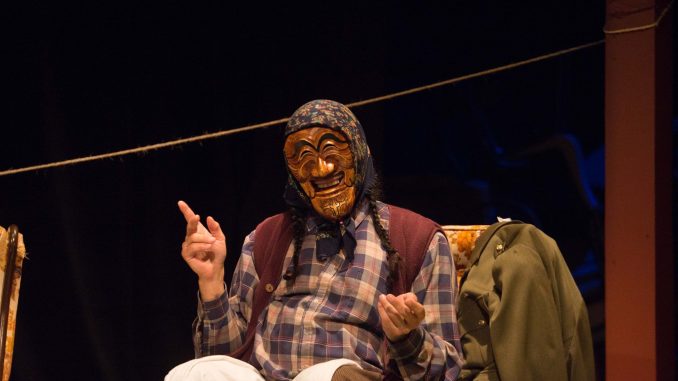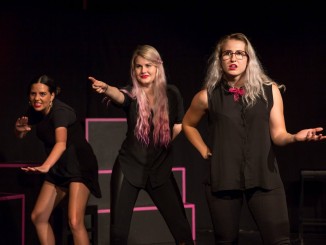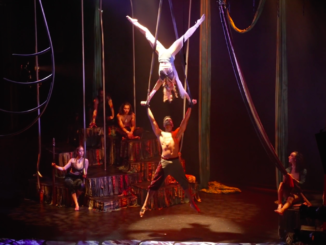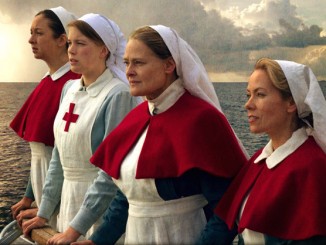
[An Adventure into the Absurd]
Reviewing theatre is a strange activity. It involves sitting self-consciously within and without your own viewpoint, inhabiting and interrogating your own responses to what’s on stage, striving for some kind of balance between subjectivity and objectivity. I say ‘striving for’, because I suspect this elusive balance doesn’t really exist; perhaps it’s more constructive just to aim for respectful, self-aware subjectivity. That’s my intention here, at least, in describing my experience of Te Pou’s He Tūru Māu last night.
To give a little context on my viewpoint, I am a twenty-seven-year old English woman. I have been in Aotearoa for a year, and to my shame, understand only a smattering of Te Reo Māori. I’m a writer, actor, avid theatre-goer and lover of language, and I was absolutely captivated by He Tūru Māu. I hope this review will illustrate why for me, it was one of the most entertaining, intellectually engaging and thought-provoking nights I’ve spent in theatre.
To cover the usual bases first, acting, design and direction all worked beautifully in Te Rehia Theatre Company’s Te Reo Māori interpretation of Ionesco’s The Chairs. Amber Curreen plays a petite and crotchety Old Man who yet comes across as appealingly exasperated by life’s ridiculousness, while Antonio Te Maioha plays the Old Man’s giant and lumberingly maternal wife, an Old Woman at once devoted to and despairing of her husband and his role as the marae’s ringa raupā, or general factotum. Chemistry between the two was physically hilarious, vocally corresponsive, and palpable in the audience’s rapt investment in these characters’ farcical antics.
Visually, the stage buzzes with strikingly cubist aesthetics thanks to Olivia Clarke-Edwards’ eye-catching set design: the bright, geometrically painted stage serves as a kind of blueprint for the characters’ heightened and highly mannered gestures and movement. Its angularity and sharply delineated segments of colour are offset, however, by a softer, more natural aesthetic that hangs from the ceiling in the form of figures and foliage, and speaks to the undercurrent of lyricism that runs through the show. Upstage, brown painted figures with curious faces and open arms are suspended, embracing what look like aged saplings, their whitened leaves carrying reference to an impermanence and fragility that challenges beautifully the human assertions of absurdism by what feels like natural law. Complemented by lighting designed by Chez Marama and Ariana Shipman, the combination of these two energies provides an atmospheric cue for a vibrant show whose life does not lie within the tramlines of realism.
Tainui Tukiwaho’s direction has embraced this departure from realism with wit and intelligence. Even without understanding the word-play I could yet sense a showmanly sleight of hand at work here, a navigation of the complex territory of translation and interpretation that felt easy and dexterous. For me it came across as a naughty glibness that made the audience complicit in theatricality – the use of mask and gesture made it impossible to forget the show’s artifice and construction, opening up both the show and the audience for non-literal and non-linguistic interpretation.
Essentially, Tukiwaho takes all the permissions granted by an absurdist play and runs with them to create a show at turns hilarious, touching, wildly irreverent, highly mischievous and hauntingly lyrical – regardless (I think) of which linguistic lens you’re watching it through.
This was my response to the show, at any rate. So, naturally I’ve been questioning that – given my lack of understanding of Te Reo, where is this interpretation coming from? The show had complex and distinct meaning to me, at both an emotional and intellectual level, so I’m curious – how did I get to that? In the absence of being fed a language I speak, to what extent am I projecting onto what I saw? How does the partial (or total) lack of verbal understanding of a show affect how audiences relate to it? What story of He Tūru Māu did I tell myself? And if I can do this about a play, where else in my life do I do this?
One of the things I found fascinating about He Tūru Māu was how it made me acutely aware of an ingrained desire to make things make sense – to create meaning for myself. This tendency transcends language; it’s a universal trait of the storytelling human mind, and cuts right to the heart of why this quadruple season of The Chairs is such a fascinating project. Absurdism as a philosophy – and its derivative art and theatre – is precisely concerned with the human quest for meaning. Plays like The Chairs dramatise Absurdism’s conundrum: that as humans we scrabble madly for meaning in a reality where meaning doesn’t exist. Absurdism believes the only sensible thing to do is accept chaos, accept the fact that ultimately, the universe is meaningless, and get on with being a decent human being.
Something that Te Pou’s series of adaptations of The Chairs is making me realise is that we never watch anything in a vacuum. We will try to bring meaning to our perceptions at all costs. What these shows also show us is that we can only do that from within the parameters of our own cultural, linguistic, emotional or intellectual perceptions. My understanding of He Tūru Māu was absolutely informed by seeing the Pākehā version. That version introduced to me the concept of a fatuous search for meaning: under Adam Rohe’s direction, we saw an old man who has strived his whole life to express his ‘message’ (some kind of treatise on the state of mankind that he believes will save the world, or at least make some difference) ultimately fail to grasp that the orator he’s hired to communicate this message is a dumb sheep, and that his pursuit of meaning will have therefore been for nothing.
So, the fact that I knew the Te Reo show was eluding me linguistically and that there were countless cultural references I was missing, made me frustrated and a little saddened – I wanted total understanding, I wanted total meaning. As an aside, I’ve never felt more motivated to learn Te Reo Māori than in the first mad ten minutes of this show, feeling like a child left out of the grown ups’ jokes. But the more I tried to interpret specific words or phrases, the less I got from the show. Some kind of reflection of Absurdist philosophy seemed to apply here, in that getting bogged down in trying to make the details mean something ‘correct’ spoils the magic and the lyricism of letting go to the overall experience.
Once I let go of the need to construct specific meaning at a verbal level, the show communicated to me in a different way. There was something inclusive about being surrounded by Te Reo speakers and knowing that there was overlap in our reactions to linguistic and physical comedy. But coming culturally from a European background and intellectually from a classical theatre background, fascinating things jumped out to me. Despite the Te Reo Māori language of He Tūru Māu, the staging of it itself still participates in the long history of theatre that stems back to Ancient Greece. For me, the potent end of the play, which saw the Old Man and Old Woman strip themselves of their masks and in so doing, die, appealed to a Greek concept of character as being contained within the mask.
That prompted a series of questions as to what the significance of moko, mask and carved representations of faces may be within Māori culture, as I became very conscious of where my own background was filling in gaps in my knowledge of the culture I find myself surrounded by here, yet understand so superficially. In this way, the show has made me more curious, and more aware of my lack of understanding, and motivated to learn more …hopefully even over the next few days in the hope I can see the show again and understand more!
The presence of a third character throughout He Tūru Māu was another instance of the paradox of vagueness trumping specificity in my experience of meaning in this version of The Chairs. Pukorero/The Orator, played by Acacia O’Connor, was an ever-present, elegant figure in a period colonial dress, her face concealed, who played the cello through a window before arriving in place of the orator with her own carved mask. Her role seemed to me to be charged with specific connotations that to me were unknown, yet when I stopped worrying about them, had a potent atmospheric meaning that helped elucidate the Old Man’s sensibility.
The Old Man’s gazing through the window into the cello’s playing of Pokarekare Ana to me signified a relationship with some kind of transcendence or spirituality – perhaps meaning in general – that conflicts with the more immediately chaotic and absurd reality he lives in with his wife, who decisively shuts an invisible blind to this window, that also kills the music, and thereby part of his spiritual life.
Talking with Tainui after the show helped me realise I had entirely seen her through the Old Man’s perspective, without even realising that an alternative view of this figure was more of a threat, as seen from the Old Woman’s perspective, as some kind of spirit of death. He also made reference to the sensitive task of handling content that would traditionally be tapu in Māori culture in He Tūru Māu. This was another whole field of meaning that I wasn’t able to understand – I had no idea of the cultural significance of the Old Man lying feet first facing the window being an evocation of a desire to die, for example. To me, it was a man lying down because he was tired of life, but I was only aware of the flippancy of the posture, and not the depth of significance against which it was leveraged.
He Tūru Māu is an incredibly intricate show, one holding so many things to ponder and reflect on, but the most powerful thing about it is that it is hugely enjoyable. You can relax into it at a superficial level and laugh till you cry, or you can really get your teeth into its meatiness. Because whether you think about it or not, a really interesting thing happens when you watch The Chairs in a language you don’t speak. It happens all by itself, and mirrors ingeniously the absurdist philosophy behind Ionesco’s original text: you find yourself suspended in conflict between the tendency to search for meaning in what you’re watching – your storytelling brain instinctively grasping for clues to bring you closer to the full understanding you so crave – and the inability to find any meaning at all.
He Tūru Māu – The Chairs – Te Reo Māori Season plays at Te Pou until 21 July.




Leave a Reply